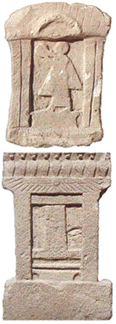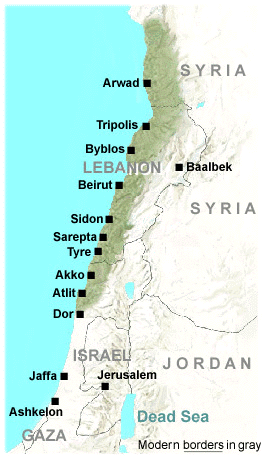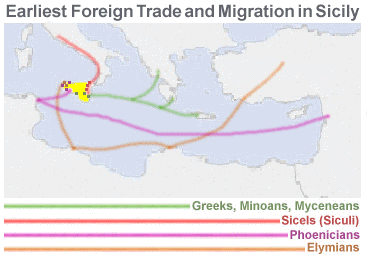...Best of Sicily presents... Best of Sicily Magazine. ... Dedicated to Sicilian art, culture, history, people, places and all things Sicilian. |
by Vincenzo Salerno | |||||
Magazine Index Best of Sicily Arts & Culture Fashion Food & Wine History & Society About Us Travel Faqs Contact Map of Sicily
|
It has been suggested that the Phoenicians, essentially a Semitic people,
arrived in the Middle East from the Persian Gulf sometime around 3000 BC.
However, the evidence for this remains inconclusive. Today, their primary
descendants include the Lebanese, Palestinians, By 1000 BC, the seafaring Phoenicians, the greatest traders of their time, were moving beyond the Strait of Gibralter to trade with Cornwall (to exploit its tin mines) and, it is thought, to navigate around Africa. There is a theory that they also reached America. Their trading colonies in western Sicily were founded around 800 BC and included Motia and Solunto as well as what are now Marsala and Palermo. When the Phoenicians' descendants, the Carthaginians, re-populated these coastal settlements three centuries later, the result was open conflict with the Greeks and then the Romans (leading to the Punic Wars). By 800 BC, both the Etruscans and Greeks had adapted the Phoenician alphabet to their own needs. Sicily's native peoples (the Sicanians, the Sicels and the Elymians) used the Phoenician alphabet almost unaltered. Relations with the Egyptians were usually good, but over time the Phoenicians found themselves at odds with the neighboring Assyrians. Their differences with their Greek neighbors dated from the Phoenicians' alliance with the Persians. The Phoenicians identified themselves by the cities of their birth. Phoenicia owes its name to a Greek word, phoinix referring to the purple dyed goods of coastal Canaan, where a non-fading, reddish-purple dye was made from the glands of murex mollusks, the dye of Tyre ("Tyrian Purple") being the best known --and eventually much preferred by the Greeks and Romans. Phoinikes literally means red people. Canaanites were sometimes called Sidonians (for their city of Sidon). By 1900 BC, Ugarit, in northern Phoenicia, traded with Crete and other eastern Mediterranean cities. The Phoenicians' Semitic language was closely related to Hebrew and distantly related to Aramaic and to the Semitic languages of Mesopotamia, such as Assyrian and Babylonian, yet Phoenician civilization was clearly distinct from these other cultures. By AD 100, Aramaic had become the popular language of Phoenicia, but Carthaginians spoke the Punic dialect of Phoenician until the sixth century. (This Carthaginian language was essentially similar to "classical" Phoenician, but characterized by what are thought to have been some "native" north African elements.) The place name Gades (now Cadiz) comes from the Phoenician word for wall. The word bible comes from the Greek word for book, which the Greeks took from the name of the Phoenician city of Byblos, famous for its papyrus, a product they imported in vast quantities. The Phoenicians' arrival in western Sicily, circa 800 BC, coincided with the Greek settlement of the island's eastern areas. Initially, the Phoenicians' Sicilian cities were primarily trading centers, while the Greeks sought full-scale colonization of Sicily. Eventually, the Greeks fought a war against the Sicels of eastern Sicily, though the Phoenicians seem to have co-existed peacefully with the Elymians of the west, effectively co-founding towns such as Eryx (Erice). Though the Carthaginians' culture was essentially Phoenician, it is more accurate to define it as a "residual" Phoenician (or "Punic") civilization of northern Africa, much as medieval Norman society represented residual Nordic civilization in northwestern France. In Sicilian history, the Phoenician presence began around 800 BC and lasted until around 500 BC. By that time, with the original Phoenician settlements of Sicily underpopulated, the Carthaginians "rediscovered" Sicily. That's when they encountered conflict with Greek expansionism. Later still, the Romans defeated the Carthaginians during the Punic Wars. (The Carthaginians will be featured in another article in this series.) Today, Punic Palermo is regarded by many to have been the most important Phoenician town in Sicily. However, such a view reflects a Carthaginian and Roman perspective, rather than a purely Phoenician one. In fact, until circa 600 BC the settlements now identified with Marsala and Solunto may still have been more important than Zis (as Palermo was probably known to the Phoenicians), whose strategic and economic prominence emerged during the later (Carthaginian) period. Preserved on easily-destroyed papyrus, Phoenician literature has largely
vanished. Consequently, the Phoenicians' history was written primarily by
their enemies, and not usually in a favorable light. The culture of the
Phoenicians (and Carthaginians) was disparaged by generations of Hellenistic
and Roman scholars, and this perspective found its way into the modern era.
Underlying motives Unfortunately, the cultural bias against the Phoenicians and their descendants continues to this day. For example, while there exist in Sicily more traces of Greek culture than Phoenician civilization, popular travel guidebooks and histories published today virtually ignore the Phoenicians and Carthaginians except for a note here or a paragraph there. To a certain extent, this reflects the "classical" emphasis of the authors' historical instruction (and also the idea that to most tourists Phoenician walls are considered less interesting than Greek temples and amphitheatres). There was a strong Egyptian influence on Phoenician art. The two stelae shown above, found at Mozia (Motya), are a fine example of this. Phoenicia itself, and in turn the Phoenician colonies across the Mediterranean, was a cultural crossroads which brought Assyrian and Babylonian myths, literature and other knowledge westward, first to Greece and then to places like Sicily, Tunisia and Spain. It is thought that this "eastern" cultural influence brought about Greece's "Golden Age" of art and literature, effectively establishing the framework of Western civilization as it has come to be known and appreciated. Egyptian culture was not overlooked, though the Egyptians had their own commercial (and eventually even dynastic) links with the Greek world. Certain Phoenician settlements offered specific resources --silver in Spain and tin in England. In Sicily terra cotta (ceramic) objects seem to have been the major product. It is fair to say that the Phoenicians dominated Mediterranean sea travel, trade and commerce for over two thousand years, a reality which probably made the ambitious Greeks at least slightly envious. Yet, for most of their glorious history the Phoenicians were not a maritime military power as we understand that term. Phoenicia was never an empire. For most of its history, Phoenicia was an essentially peaceful, loosely-united "confederation" of independent city-states which usually maintained good relations with its powerful neighbors to the east and south. There is little doubt that the Phoenicians influenced early Sicily. In many cases, however, we cannot state with certainty whether particular developments (such as the introduction of papyrus in Sicily) are more properly attributed to the Phoenicians or to the Greeks. Bearing in mind that in Sicily the Phoenicians were essentially traders and the Greeks primarily colonists, it seems probable that the Greeks did indeed introduce the cultivation of edible olives on a wide scale, and perhaps grapes too. However, there is no clear evidence that the Phoenicians did not introduce certain grape varieties --and perhaps winemaking itself. That said, the cultures of the Aoelian (Lipari) Islands and certain coastal Ionian communities enjoyed contact with "Hellenistic" cultures, such as those of the Minoans and Myceneans, centuries before the arrival of the Phoenicians. At issue, however, is the fact that the Hellenistic record provides the first documented evidence of these developments, with no surviving Phoenician record existing to challenge it. In this way, the Phoenicians may be the "Vikings" of the Mediterranean, their adventurous, seafaring legacy known to us but their contributions rarely confirmed by reliable (and unbiased) written records. It is a fact that the Phoenicians controlled the Strait of Gibralter and navigated some distance southward along Africa's Atlantic coast. Their theorized (but unproven) circumnavigation of Africa, mentioned by the Greek historian Herodotus, would have been a remarkable achievement, but it has also been postulated that the Phoenicians ventured across the Atlantic to the Americas. Based on the shipbuilding technology of their time, both voyages would have been challenging, though perhaps not impossible. An interesting aspect regarding the African theory is that, presumably through the Phoenicians and Greeks, it became known with certainty that Africa was a continent set in a sea, and not an infinite land mass --something which could not otherwise have been known to ancient peoples. In any event, reaching England appears to have been a reasonably simple task for the Phoenicians. Most of their landings in Sicily were the results of shorter voyages of just a few days' duration, departing from ports in Tunisia or Sardinia. Carthage, the greatest Phoenician colony, was probably founded by traders
from Tyre shortly before 800 BC (though some scholars claim a foundation
of circa 860 BC), Zis (Palermo) and Gadir (Cadiz) probably just a few decades
later, with Motya (Motia) and Solus (Solunto) settled about the same time.
Mount Eryx was a point of reference for Phoenician navigators. The origins
of the town of Eryx (Erice) are somewhat "multicultural," as this
appears to have been an Elymian center before the arrival of the Phoenicians,
who established there a temple to Astarte (their goddess of fertility),
later identified with Aphrodite by the Greeks, and with Venus by the Romans.
By 580 BC, the Owing partly to events in Phoenicia, Carthage and the other Phoenician cities across the Mediterranean soon became independent. The Assyrians captured Phoenicia in 842 BC and controlled the region for two centuries. The Babylonians briefly controlled Phoenicia from 612 BC. In 539 BC, Phoenicia fell to the Persians, who seem to have permitted a degree of autonomy. In the Persian Wars (490-479 BC) against Greece, the Phoenician fleet played a key role, though it suffered serious losses at the Battle of Salamis (480 BC). The Phoenicians' forced alliance with Persia appears to have earned the antipathy of the Greeks of the central Mediterranean, and this resentment was directed toward the Phoenician societies of Carthage, Zis and Motya. Alexander the Great captured Tyre in 332 BC, bringing Phoenicia into the Greco-Macedonian sphere of influence. The culture of Phoenicia rapidly became Hellenized, though Aramaic was already the language of the common people and continued to be used. Distant Carthage preserved the original language and culture of the Phoenicians. The Phoenician-Carthaginian influence represents one of two major Semitic colonizations in Sicily, the other being that of the medieval Saracens (Moors). Until 1492, there were also Jewish communities present in many cities. Thus far, genetic traces of the Phoenicians have been more clearly identified in the population of Malta than among Sicilians, though much research remains to be undertaken in this area. It is reasonable to presume that the Phoenician-Carthaginian genetic link, if identified, would be more pronounced in western Sicily than in the island's eastern regions. The cultural link is certainly a powerful one; it includes the letters on this page. About the Author: Palermo native Vincenzo Salerno has written biographies of several famous Sicilians, including Frederick II and Giuseppe di Lampedusa. | ||||
Top of Page |
 They founded settlements
across the Mediterranean --places like
They founded settlements
across the Mediterranean --places like  many Syrians and some Egyptians.
Beyond the shores of the eastern Mediterranean, the people of Sicily, Spain,
Sardinia, Tunisia and Malta boast at least some Phoenician blood, as well
as a distinguished Phoenician cultural heritage.
many Syrians and some Egyptians.
Beyond the shores of the eastern Mediterranean, the people of Sicily, Spain,
Sardinia, Tunisia and Malta boast at least some Phoenician blood, as well
as a distinguished Phoenician cultural heritage. may have reflected dominant Romanist (and Paleo-Christian)
and Judaic ideas, but the trend may simply have been part of a subtle effort
to disdain a defeated people in favor of the victors. Certain oft-cited
social phenomena (such as the Carthaginians' reputed ritual sacrifice of
children) were not unique to the Phoenicians, nor were they even necessarily
known to most Greeks and Romans. Indeed, many Phoenician deities corresponded
to Greek (and then Roman) ones, and their society and religion were not
markedly different from what one would have encountered in ancient Athens
or Rome.
may have reflected dominant Romanist (and Paleo-Christian)
and Judaic ideas, but the trend may simply have been part of a subtle effort
to disdain a defeated people in favor of the victors. Certain oft-cited
social phenomena (such as the Carthaginians' reputed ritual sacrifice of
children) were not unique to the Phoenicians, nor were they even necessarily
known to most Greeks and Romans. Indeed, many Phoenician deities corresponded
to Greek (and then Roman) ones, and their society and religion were not
markedly different from what one would have encountered in ancient Athens
or Rome. Greeks were already attempting to drive the Phoenicians from
Sicily. They failed, but in the 550s the Carthaginians formed an alliance
with the Etruscans intended to check Greek expansionism in the central Mediterranean.
The Elymians (who were gradually amalgamating with the Greeks) played little
part in this, though Segesta and other Elymian towns eventually became Hellenized
in every respect.
Greeks were already attempting to drive the Phoenicians from
Sicily. They failed, but in the 550s the Carthaginians formed an alliance
with the Etruscans intended to check Greek expansionism in the central Mediterranean.
The Elymians (who were gradually amalgamating with the Greeks) played little
part in this, though Segesta and other Elymian towns eventually became Hellenized
in every respect.